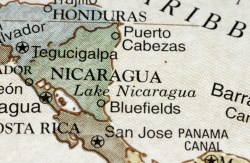
“Let’s cut it in two and let shipping through.”
Nicaragua is one step closer to being carved in half by a massive cross-country canal. Leftist President Daniel Ortega rammed the project through his country’s congress last week.
The lawmakers gave the Hong Kong-based HKND Group a 50-year concession to excavate and operate the canal, which is intended to rival Panama’s. If it’s actually built — and that’s still a big if — it promises to give an economic boost to the bitterly poor country. Nicaragua would get a minority share of profits and, say backers, tens of thousands of jobs too.
But critics warn that would come at the expense of the environment and clean water supplies. From Agence France-Presse:
Centro Humboldt environmental group deputy director Victor Campos told AFP the project to link Nicaragua’s Atlantic and Pacific coasts will jeopardize the watershed that supplies water to most of the impoverished country’s population when it transits through Lake Nicaragua. …
HKDN spokesman Ronald MacLean said the company was considering four possible routes for the waterway, and all would necessarily go across Lake Nicaragua.
In the lake lies an island with an active volcano and some 300 islets that serve as breeding grounds for the American crocodile (Crocodylus acutus), the largest reptile living in Central America and the Caribbean.
One of the possible canal routes would pass through the sprawling Cerro Silva nature reserve between the southern Caribbean coast and the El Rama River port, home to coastal ecosystems, wetlands and tropical forests that environmentalists warn could disappear.
Also in the path of the construction is the Punta Gorda nature reserve in the southern Caribbean, home to more than 120 species of birds, mammals, reptiles, fish, amphibians, mollusks and crustaceans.
MacLean said environmental experts would be hired to measure and minimize environmental and social impacts. But groundbreaking is initially scheduled for May 2014, less than a year away, providing precious little time to prepare environmental analyses and recommendations.
Independent experts are skeptical, meanwhile, saying the plan would be so hard to pull off that it may never be realized. From The New York Times:
Experts say that while the approval process led by President Daniel Ortega has been swift, environmental opposition, changes in shipping patterns and construction costs could easily thrust the proposal onto the large list of discarded plans for a Nicaraguan canal.
“It’s not going to happen, that was my first reaction,” said Noel Maurer, an associate professor at the Harvard Business School who helped write a book about the Panama Canal. “A pipe dream might be too strong, but I would just consider it a really bad investment.”
The challenges for Nicaraguan canal planners have always been enormous, and the current project is nothing if not ambitious. It would entail slashing through around 180 miles of thick tropical terrain — roughly triple the length of the Panama Canal — and then pumping a virtual sea through a series of locks deep enough for massive cargo ships.
Activists are already protesting the plans. “Nicaragua isn’t for sale,” the Movement for Nicaragua, a coalition of civil-society groups, wrote in an open letter to the country, the AP reports. “Nicaragua belongs to all Nicaraguans and isn’t the private property of Ortega and his family.”



